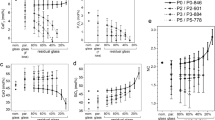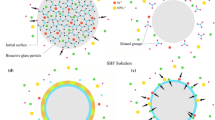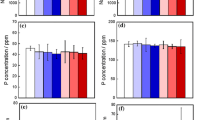Abstract
Strontium (Sr) enhances bone formation both in vitro and in vivo, while it reduces bone resorption. Thus, Sr incorporation in bioactive glass–ceramic scaffolds for bone tissue regeneration could further enhance osteogenesis. The aim of this work was the synthesis, characterization and investigation of the apatite-forming ability in inorganic environment of two sol–gel-derived bioactive Sr-containing glass–ceramic materials with 5 and 10% of SrO. The thermal properties of the synthesized materials were studied using differential thermal analysis (TG–DTA). The apatite-forming ability test was conducted in SBF for various immersion times for both thermally treated and untreated samples. The characterization of the samples before and after immersion in SBF was performed with Fourier transform infrared spectroscopy (FTIR), X-ray powder diffraction (XRD) and scanning electron microscopy with associated energy-dispersive spectroscopy. FTIR spectra revealed that all synthesized glass–ceramic materials presented the characteristic bands of silicate glasses, while XRD identified various crystalline phases, mostly calcium silicates. Strontium is present in the form of strontium silicate in both as-received and thermally treated specimens, and Sr-diopside in the thermally treated specimens. The apatite-forming ability of the glass–ceramic materials was confirmed by the formation of a hydroxyapatite layer after 3 and 5 days of immersion in SBF on the surface of the untreated and thermally treated samples, respectively. The apatite layer, also, became thicker as the immersion time increased.







Similar content being viewed by others
References
Ratner BD, Hoffman AS, Schoen FJ, Lemons JE (2013) Biomaterials science: an introduction to materials in medicine, 3rd edn. Elsevier Inc., Oxford
Ong KL, Lovald S, Black J (2014) Biological performance of materials in research and practice. Taylor and Francis Group, Boca Raton
Doremus RH (1992) Review bioceramics. J Mater Sci 27:285–297. doi:10.1007/BF00543915
Kokubo T (1997) Novel bioactive materials. An Quím Inter Edn 93(1):549–555
Hench LL, Kokubo T (1988) Handbook of biomaterial properties. Chapman and Hall, London by Black J and Hastings G
Hench LL (1991) Bioceramics: from concept to clinic. J Am Ceram Soc 74(7):1487–1510
Peitl Filho O, LaTorre GP, Hench LL (1996) Effect of crystallization on apatite-layer formation of bioactive glass 45S5. J Biomed Mater Res 30(4):509–514
Vallet-Regi M (2001) Ceramics for medical applications. J Chem Soc Dalton Trans 2:97–108
Caruta BM (2006) Ceramics and composite materials: new research. Nova Science Publishers Inc., New York
Hench LL, Splinter RJ, Allen WC, Greenlee TK Jr (1971) Bonding mechanisms at the interface of ceramic prosthetic materials. J Biomed Mater Res 2:117–141
Greenlee TK Jr, Beckham CA, Crebo AR, Malmborg JC (1972) Glass ceramic bone implants. J Biomed Mater Res 6:235–244
Hoppe A, Güldal NS, Boccaccini AR (2011) A review of the biological response to ionic dissolution products from bioactive glasses and glass-ceramics. Biomaterials 32:2757–2774
Hench LL, Thompson I (2010) Twenty-first century challenges for biomaterials. J R Soc Interface 7:379–391
Hench LL, Jones JR, Sepulveda P (2005) Bioactive materials for tissue engineering scaffolds. Imperial College Press, London
Marie PJ, Ammann P, Boivin G, Rey C (2001) Mechanisms of action and therapeutic potential of strontium in bone. Calcif Tissue Int 69(3):121–129
Baino F, Fiorilli S, Vitale-Brovarone C (2016) Bioactive glass-based materials with hierarchical porosity for medical applications: review of recent advances. Acta Biomater 42:18–32
Rahaman MN, Day DE, Bal BS, Fu Q, Jung SB, Bonewald LF, Tomsia AP (2011) Bioactive glass in tissue engineering. Acta Biomater 7(6):2355–2373
Wu C, Chang J (2006) A novel akermanite bioceramic: preparation and characteristics. J Biomater Appl 21:119–129
Xynos ID, Edgar AJ, Buttery LDK, Hench LL, Polak M (2001) Gene-expression profiling of human osteoblasts following treatment with the ionic products of Bioglass® 45S5 dissolution. J Biomed Mater Res 55(2):151–157
Jones JR (2012) Review of bioactive glass: from hench to hybrids. Acta Biomater 9:4457–4486
Baino F, Novajra G, Miguez-Pacheco V, Boccaccini AR, Vitale-Brovarone C (2016) Bioactive glasses: Special applications outside the skeletal system. J NonCrystal Sol 432(Part A):15–30
Wu C, Chang J (2014) Multifunctional mesoporous bioactive glasses for effective delivery of therapeutic ions and drug/growth factors. J Control Release 193:282–295
Marie PJ (2006) Strontium ranelate: a physiological approach for optimizing bone formation and resorption. Bone 38(2, Suppl. 1):10–14
Meunier PJ, Slosman DO, Delmas PD, Sebert JL, Brandi ML, Albanese C, Lorenc R, Pors-Nielsen S, De Vernejoul MC, Roces A, Reginster JY (2002) Strontium ranelate: dose-dependent effects in established postmenopausal vertebral osteoporosis—a 2-year randomized placebo controlled trial. J Clin Endocrinol Metab 87(5):2060–2066
Bonnelye E, Chabadel A, Saltel F, Jurdic P (2008) Dual effect of strontium ranelate: stimulation of osteoblast differentiation and inhibition of osteoclast formation and resorption in vitro. Bone 42:129–138
Hesaraki S, Alizadeh M, Nazarian H, Sharifi D (2010) Physico-chemical and in vitro biological evaluation of strontium/calcium silicophosphate glass. J Mater Sci Mater Med 21(2):695–705. doi:10.1007/s10856-009-3920-0
Lao J, Jallot E, Nedelec JM (2008) Strontium-delivering glasses with enhanced bioactivity: a new biomaterial for antiosteoporotic applications? Chem Mater 20(15):4969–4973
Gentleman E, Fredholm YC, Jell G, Lotfibakhshaiesh N, O’Donnell MD, Hill RG, Stevens MM (2010) The effects of strontium-substituted bioactive glasses on osteoblasts and osteoclasts in vitro. Biomaterials 31(14):3949–3956
Zhong J, Greenspan DC (2000) Processing and properties of sol–gel bioactive glasses. J Biomed Mater Res 53(6):694–701
Wu C, Chang J (2004) Synthesis and apatite-formation ability of akermanite. Mater Lett 58(19):2415–2417
Wu C, Chang J, Zhai W, Ni S, Wang J (2006) Porous akermanite scaffolds for bone tissue engineering: preparation, characterization, and in vitro studies. J Biomed Mater Res 78(1):47–55
Brinker CJ (1988) Hydrolysis and condensation of silicates: effects on structure. J Non-Cryst Solids 100:31–50
Wu C, Chang J (2007) Degradation, bioactivity, and cytocompatibility of diopside, akermanite, and bredigite ceramics. J Biomed Mater Res 83B:153–160
Kokubo T, Kushitani H, Sakka S, Kitsugi T, Yamamuro T (1990) Solutions able to reproduce in vivo surface-structure changes in bioactive glass-ceramic A-W. J Biomed Mater Res 24:721–734
Kantiranis N, Stergiou A, Filippidis A, Drakoulis A (2004) Calculation of the percentage of amorphous material using PXRD patterns. Bull Geol Soc Greece 36:446–453
Chatzistavrou X, Zorba T, Chrissafis K, Kaimakamis G, Kontonasaki E, Koidis P, Paraskevopoulos KM (2006) Influence of particle size on the crystallization process and the bioactive behavior of a bioactive glass system. J Therm Anal Calorim 85(2):253–259
Bizari D, Rabiee M, Moztarzadeh F, Tahiriri M, Alavi SH, Masael R (2013) Synthesis, characterization and biological evaluation of sol-gel derived nanomaterial in the ternary system 64%SiO2–31%CaO–5%P2O5 as a bioactive glass: in vitro study. Ceram Silikáty 57(3):201–209
Frost R, Hales M, Martens W (2009) Thermogravimetric analysis of selected group(II) carbonate minerals—implication for the geosequestration of greenhouse gases. J Therm Anal Calorim 95(3):999–1005
Massera J, Petit L, Cardinal T, Videau JJ, Hupa M, Hupa L (2013) Thermal properties and surface reactivity in simulated body fluid of new strontium ion-containing phosphate glasses. J Mater Sci Mater Med 24(6):1407–1416. doi:10.1007/s10856-013-4910-9
Lefebvre L, Chevalier J, Gremillard L, Zenati R, Thollet G, Bernache-Assolant D, Govin A (2007) Structural transformations of bioactive glass 45S5 with thermal treatments. Acta Mater 55:3305–3313
Goudouri OM, Kontonasaki E, Kantiranis N, Chatzistavrou X, Papadopoulou L, Koidis P, Paraskevopoulos KM (2009) Investigation of the bioactivity of dental ceramic/bioactive glass composites prepared by the sol gel route. Key Eng Mater 396–398:119–122
Lenza RFS, Vasconcelos WL (2001) Preparation of silica by sol-gel method using formamide. Mater Res 4(3):189–194
Farmer VC (1973) Chapter 15 the layer silicates. In: Farmer VC (ed) The infrared spectra of minerals. Mineralogical Society, London, pp 352–353
Shannon RD (1976) Revised effective ionic radii and systematic studies of interatomic distances in halides and chalcogenides. Acta Cryst A 32(5):751–767. doi:10.1107/S0567739476001551
Martin RA, Twyman HL, Rees GJ, Barney ER, Moss RM, Smith JM, Hill RG, Cibin G, Charpentier T, Smith ME, Hanna JV, Newport RJ (2012) An examination of the calcium and strontium site distribution in bioactive glasses through isomorphic neutron diffraction, X-ray diffraction, EXAFS and multinuclear solid state NMR. J Mater Chem 22:22.212–22.223
Hill RG, Stamboulis A, Law RV, Clifford A, Towler MR, Crowley C (2004) The influence of strontium substitution in fluoroapatite glasses and glass–ceramics. J Non-Cryst Solids 336(3):223–229
Ogino M, Ohuchi F, Hench LL (1980) Compositional dependence of the formation of calcium phosphate films on bioglass. J Biom Mater Res 14(1):55–64
Filgueiras MR, La Torre G, Hench LL (1993) Solution effects on the surface reactions of a bioactive glass. J Biomed Mater Res 27(4):445–453
Smith B (1998) Infrared spectra interpretation: a systematic approach. CRC Press, Florida
Goudouri OM, Kontonasaki E, Chrissafis K, Zinn K, Hoppe A, Detsch R, Paraskevopoulos KM, Boccaccini AR (2014) Towards the synthesis of an Mg-containing silicate glass–ceramic to be used as a scaffold for cementum/alveolar bone regeneration. Ceram Int 40(10B):16287–16298
Diba M, Tapia F, Boccaccini AR, Strobel LA (2012) Magnesium-containing bioactive glasses for biomedical applications. Int J Appl Glass Sci 3(3):221–253. doi:10.1111/j.2041-1294.2012.00095.x
Oliveira J, Correia R, Fernandes M, Rocha J (2000) Influence of the CaO/MgO ratio on the structure of phase-separated glasses: a solid state 29Si and 31P MAS NMR study. J Non Cryst Solids 265:221–229. doi:10.1016/S0022-3093(99)00957-6
Fredholm YC, Karpukhina N, Brauer DS, Jones JR, Law RV, Hill RG (2012) Influence of strontium for calcium substitution in bioactive glasses on degradation, ion release and apatite formation. J R Soc Interface 9(70):880–889. doi:10.1098/rsif.2011.0387
Ostwald W (1897) The formation and changes of solids. Z Phys Chem 22:289–330
Zhou GT, Yao QZ, Fu SQ, Guan YB (2010) Controlled crystallization of unstable vaterite with distinct morphologies and their polymorphic transition to stable calcite. Eur J Miner 22(2):259–269. doi:10.1127/0935-1221/2009/0022-2008
Ogino T, Suzuki T, Sawada K (1987) The formation and transformation mechanism of calcium carbonate in water. Geochim Cosmochim Acta 51(10):2757–2767
Lin Y, Hu Q, Chen J, Ji J, Teng HH (2009) Formation of metastable CaCO3 polymorphs in the presence of oxides and silicates. Cryst Growth Des 9(11):4634–4641. doi:10.1021/cg900085e
Gal A, Weiner S, Addadi L (2010) The stabilizing effect of silicate on biogenic and synthetic amorphous calcium carbonate. J Am Chem Soc 132(38):13208–13211. doi:10.1021/ja106883c
Kellermeier M, Glaab F, Klein R, Melero-García E, Kunz W, García-Ruiz JM (2013) The effect of silica on polymorphic precipitation of calcium carbonate: an on-line energy-dispersive X-ray diffraction (EDXRD) study. Nanoscale 5(15):7054–7065. doi:10.1039/c3nr00301a
Kitamura M (2001) Crystallization and transformation mechanism of calcium carbonate polymorphs and the effect of magnesium ion. J Colloid Interface Sci 236(2):318–327
Nebel H, Epple M (2008) Continuous preparation of calcite, aragonite and vaterite, and of magnesium substituted amorphous calcium carbonate (Mg-ACC). Zeitschrift für anorganische und allgemeine Chemie 634(8):1439–1443. doi:10.1002/zaac.200800134
Lee JH, Madden AS, Kriven WM, Tas AC (2014) Synthetic aragonite (CaCO3) as a potential additive in calcium phosphate cements: evaluation in tris-free SBF at 37 °C. J Am Ceram Soc 97(10):3052–3061. doi:10.1111/jace.13124
Author information
Authors and Affiliations
Corresponding author
Ethics declarations
Conflict of interest
The authors declare that they have no conflict of interest.
Rights and permissions
About this article
Cite this article
Dessou, N.S., Theodorou, G.S., Kantiranis, N. et al. Influence of strontium for calcium substitution on the glass–ceramic network and biomimetic behavior in the ternary system SiO2–CaO–MgO. J Mater Sci 52, 8871–8885 (2017). https://doi.org/10.1007/s10853-017-0914-z
Received:
Accepted:
Published:
Issue Date:
DOI: https://doi.org/10.1007/s10853-017-0914-z




